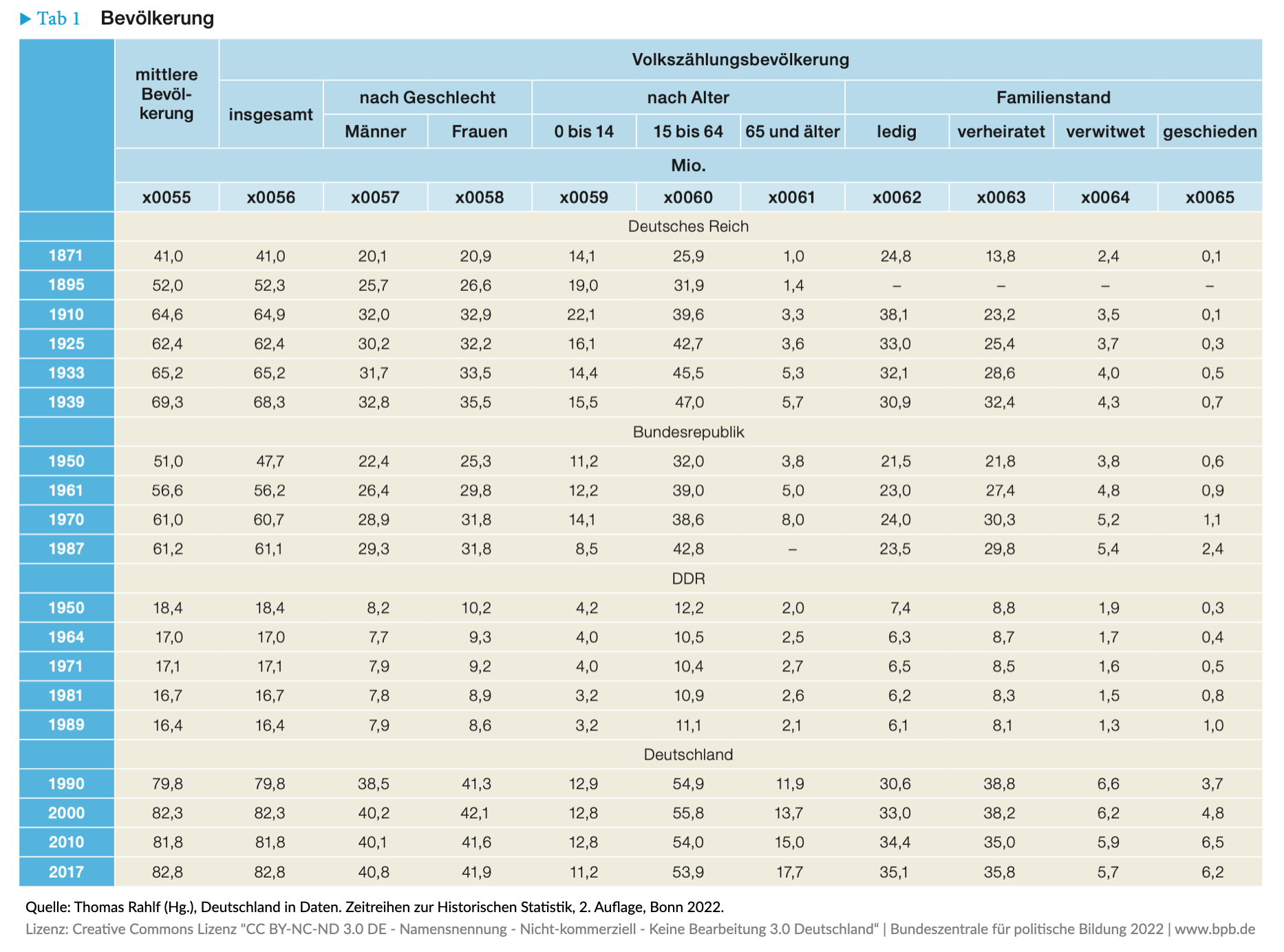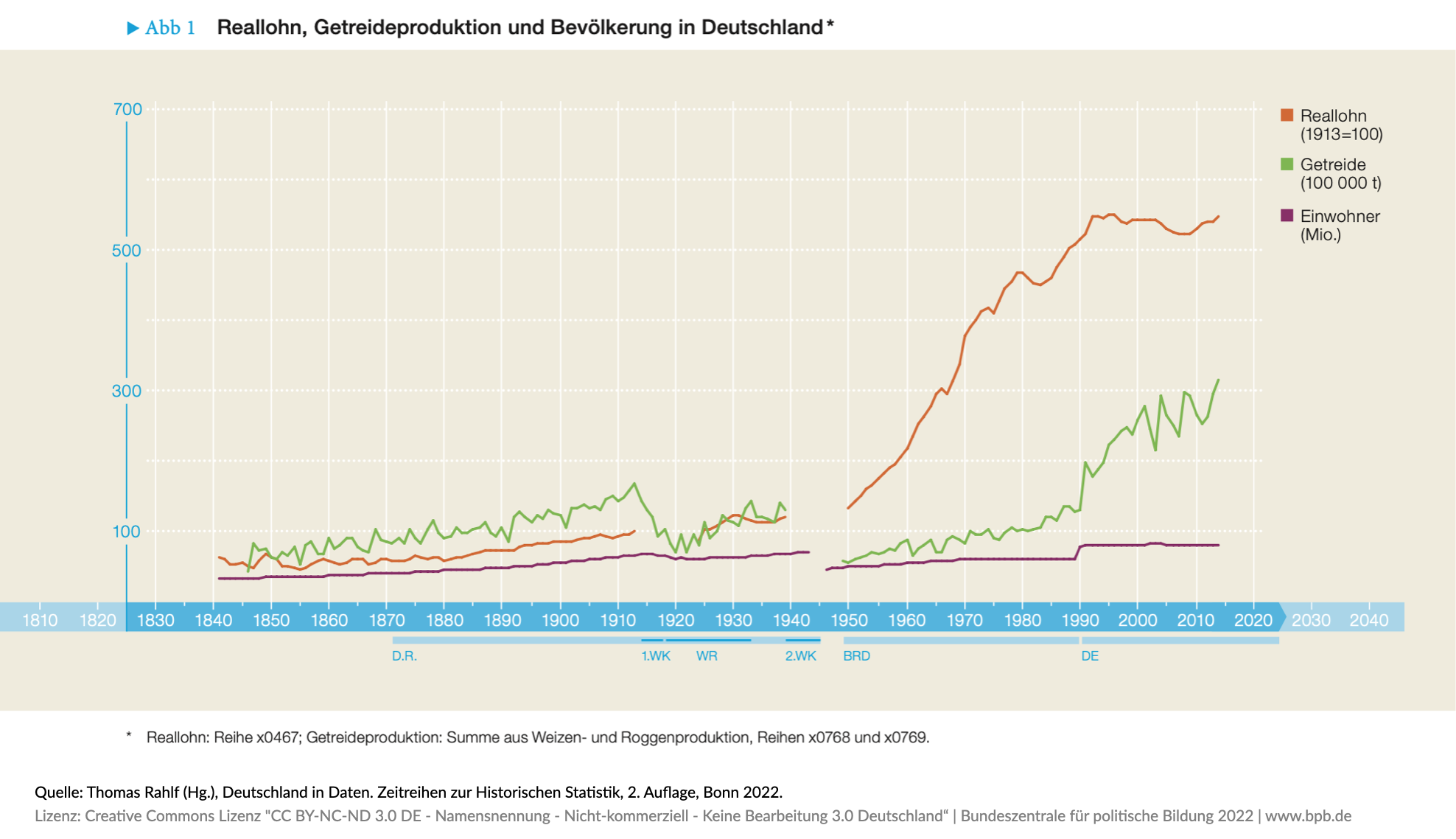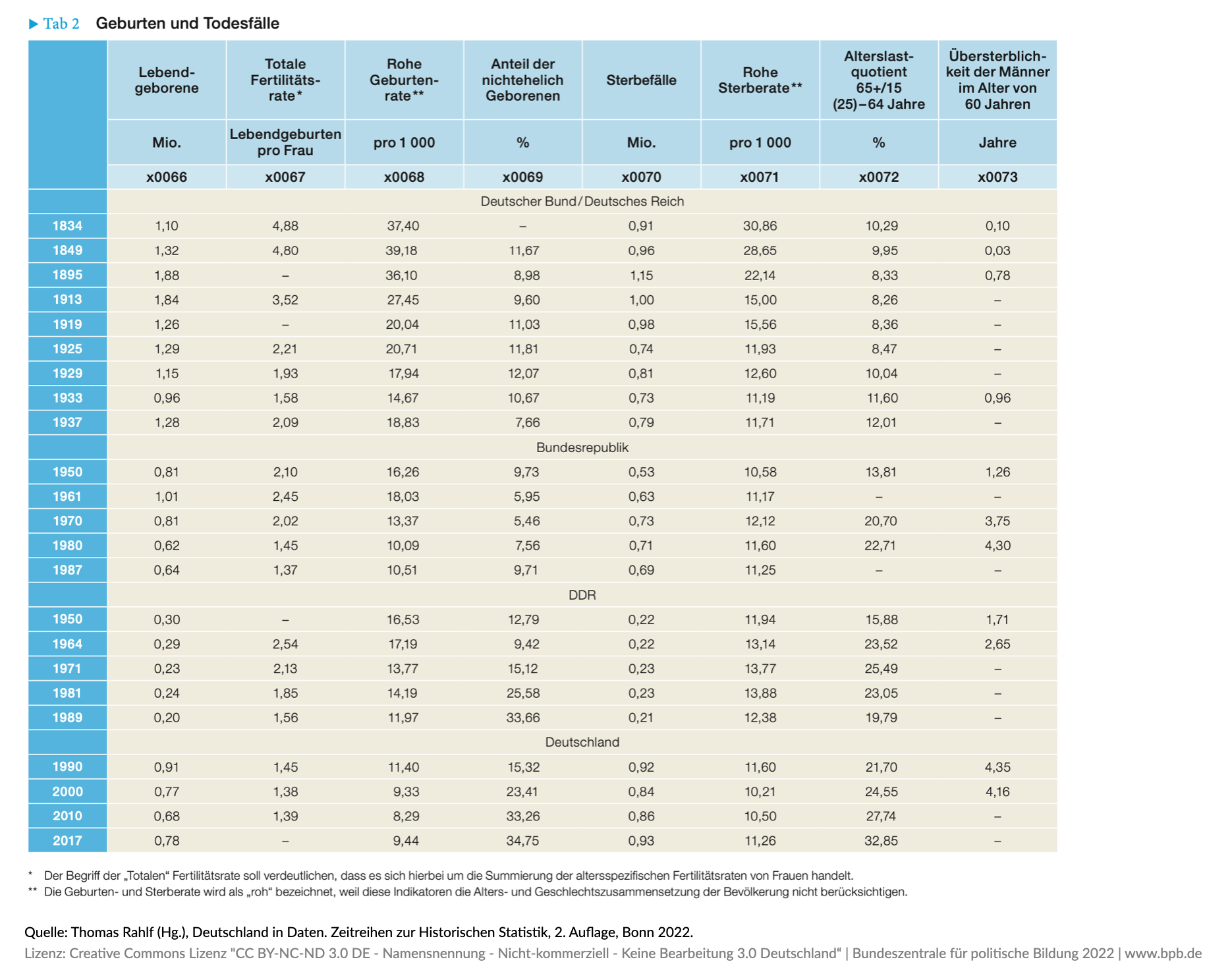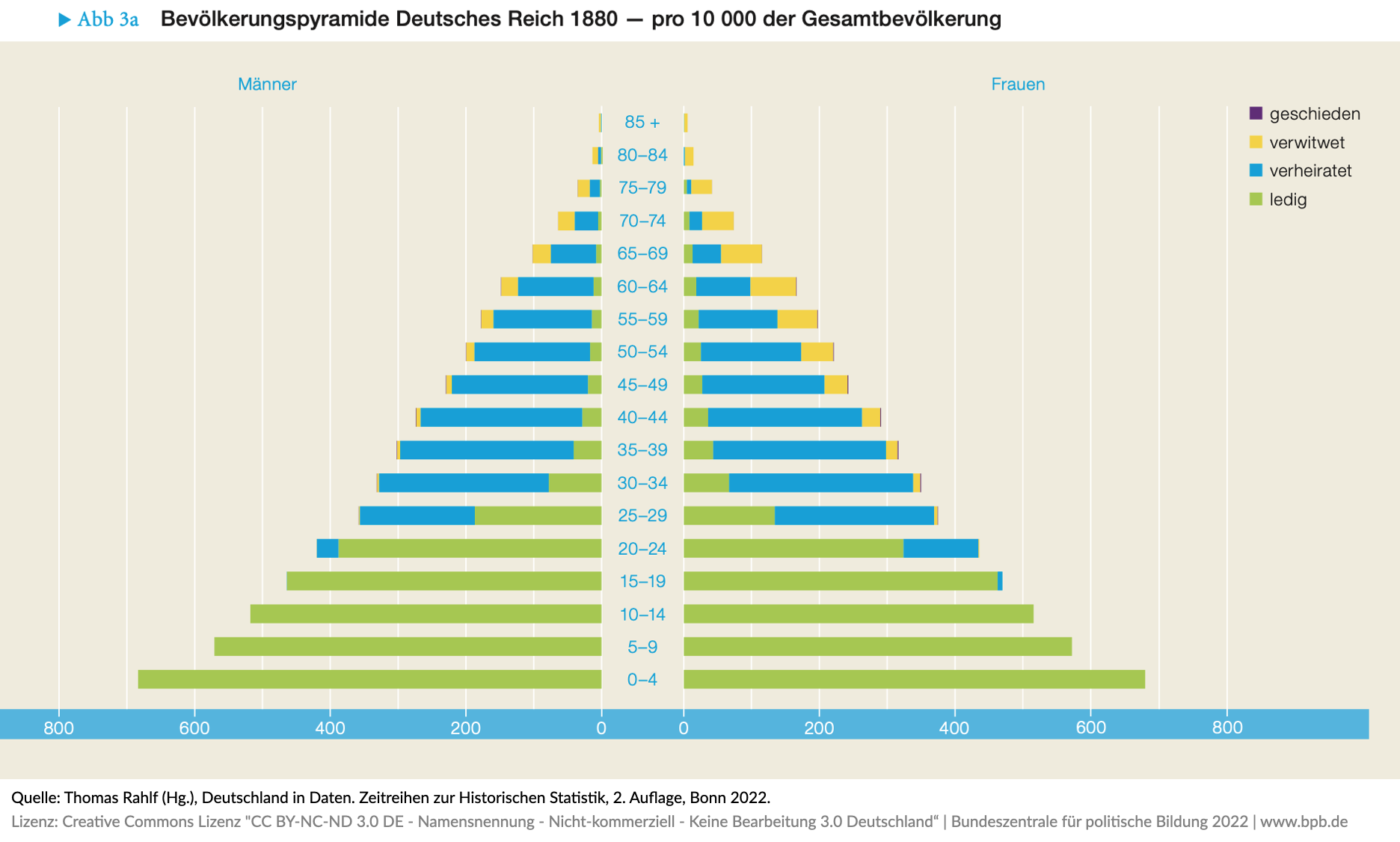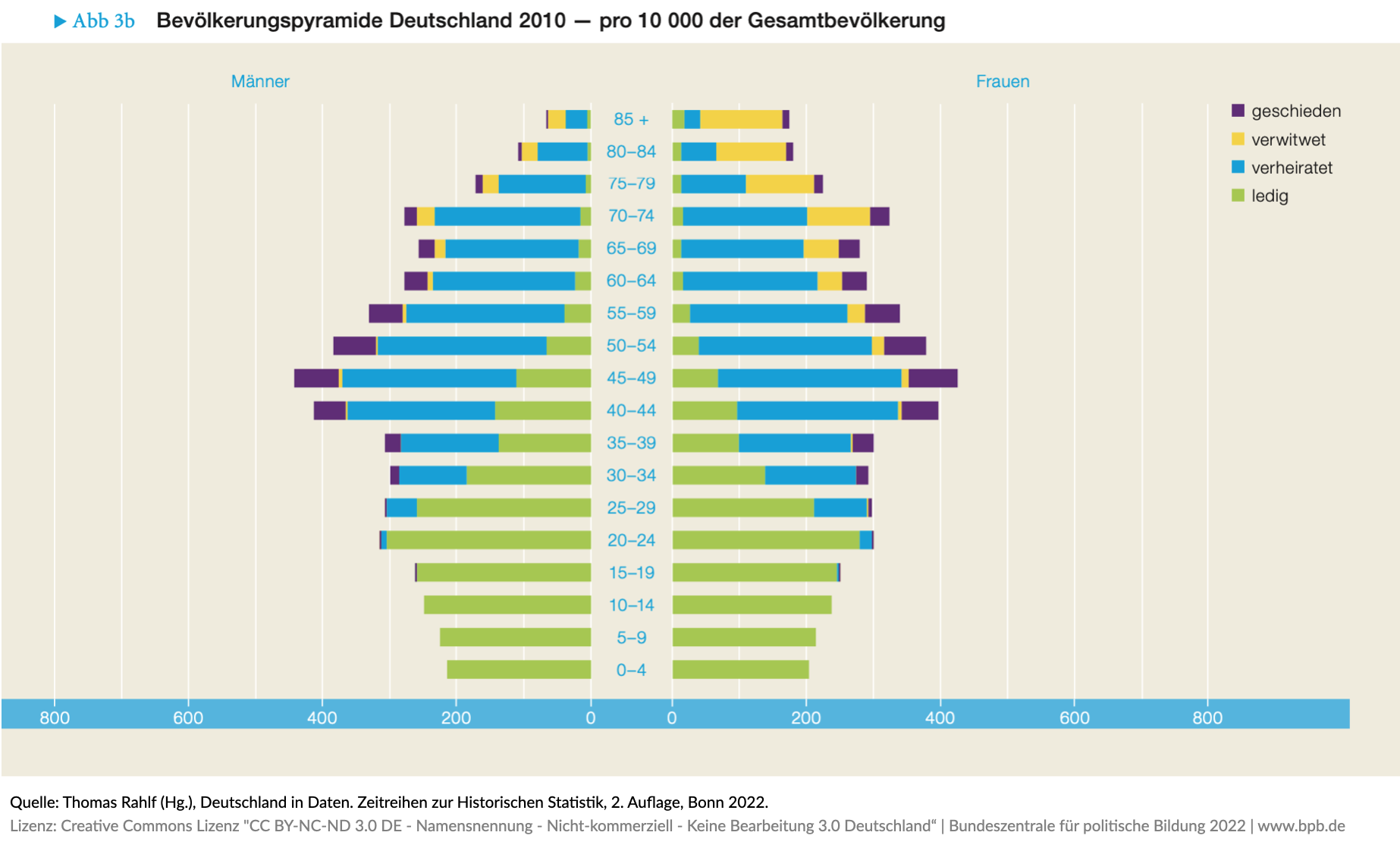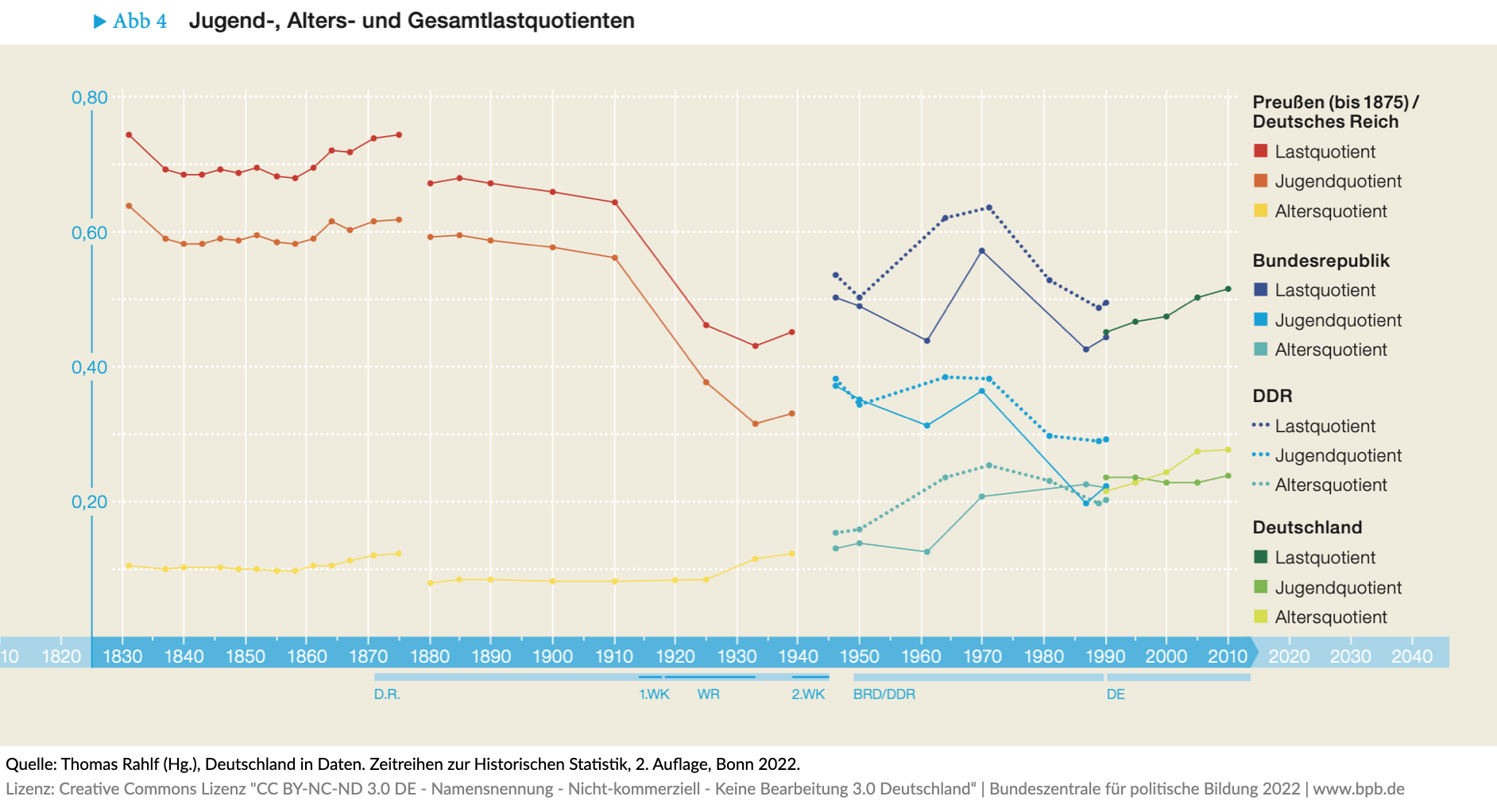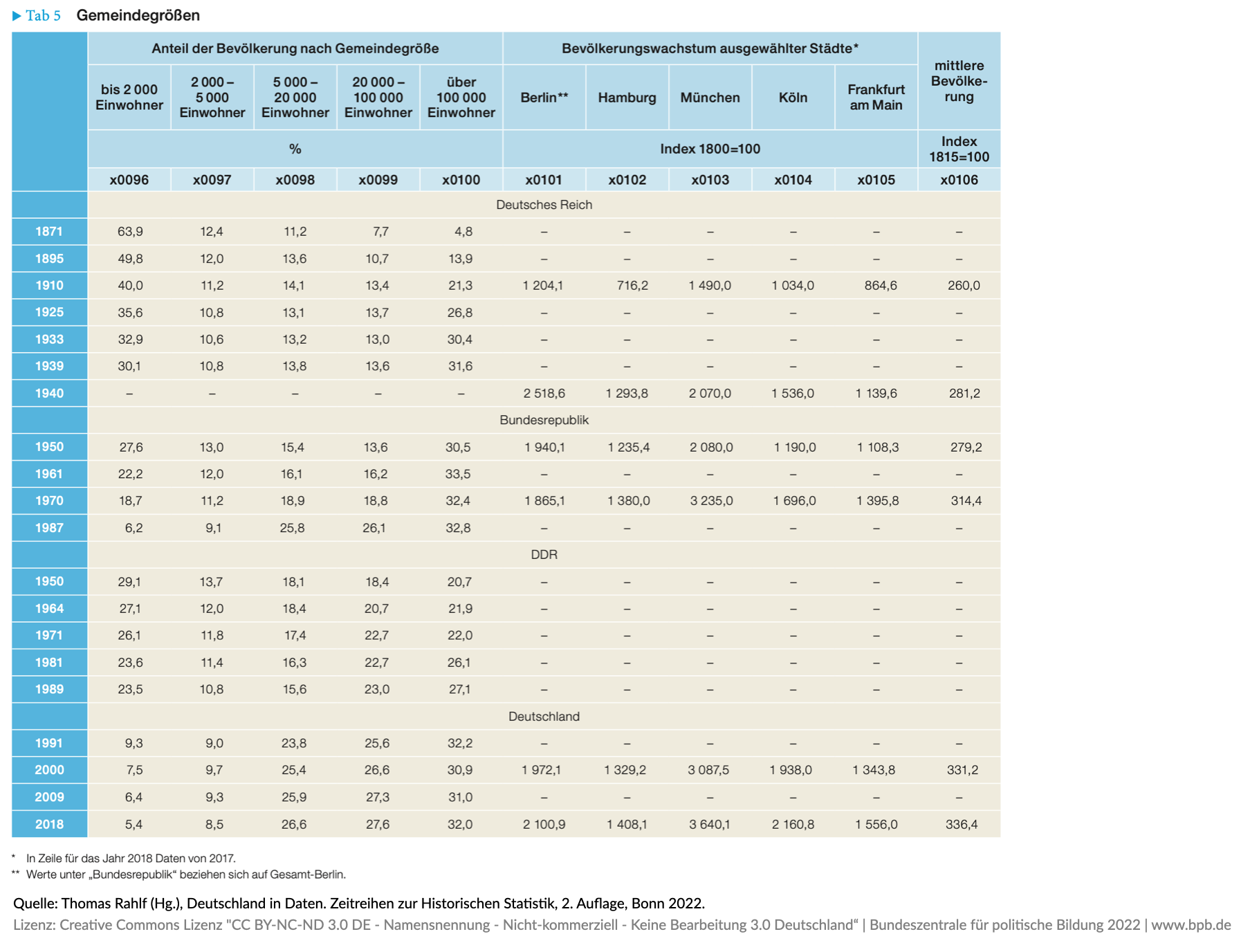Population, Households, and Families
Franz Rothenbacher
University of Mannheim
franz.rothenbacher@mzes.uni-mannheim.de
Georg Fertig
University of Halle-Wittenberg
georg.fertig@geschichte.uni-halle.de
English translation of Franz Rothenbacher and Georg Fertig, Bevölkerung, Haushalte und Familien, in: Thomas Rahlf (Ed.), Deutschland in Daten. Zeitreihen zur Historischen Statistik, Bonn: Bundeszentrale für politische Bildung 2015, pp. 30–45.
Translation by Franz Rothenbacher. The authors are grateful to Hannah Laumann and Sharmila Cohen for language editing of the manuscript.
Citation
Franz Rothenbacher and Georg Fertig, Population, Households, and Families, in: www.deutschland-in-daten.de, 10.05.2016 < http://www.deutschland-in-daten.de/en/population >.
Copyright (c) 2016 by Deutschland in Daten, and the authors, all rights reserved. This work may be copied and redistributed for non-commercial, educational purposes, if permission is granted by the author and usage right holders. For permission please contact kontakt@deutschland-in-daten.de.
Introduction
In the last two centuries, the demographic history of Germany has been shaped by three fundamental changes, which – when considered together – have driven us into a completely different world: the escape from the Malthusian Trap, the demographic transition, and the disappearance of many of the social functions of household and family. The first process implies that constant income growth became possible and, unlike before, it was no longer being consumed by a growing population; the second process implies that birth and death rates declined irreversibly; and the third process implies that present-day society is less organized around the union of man and woman, and therefore, the social roles of husband and wife do not determine our lives as comprehensively as before. In this chapter, these three processes will be examined in more detail and the extent to which they manifest themselves in the time series we document here will be presented.
Population, income, and crises
The founder of demography, Thomas Robert Malthus, was fundamentally correct in claiming that premodern societies – and not only those in Germany – were characterized by an unfavorable relationship of incomes to births and deaths. One side of this relationship was that population growth regularly led to a decline in incomes (in economics, this is known as “diminishing marginal returns”). The other side was that changes in income had significant demographic consequences, as an increase of the general income also brought about fewer deaths, more children, and consequently, a rising population. While there was no breaking out of this trap for a long time, this mechanism essentially stopped being functioning by around 1840 – despite the somber predictions of Malthus and his large group of pessimistic supporters also in Germany.1 Figure 1 uses a long-term perspective to illustrate the absolute population, side by side with real wages and production of grains, which serve as indicators of income or food intake options. At the beginning of our time period, it already becomes very clear that per capita nutrition and income were fluctuating at a relatively constant level, despite the fact that the population was growing rapidly. Furthermore, incomes have come to surpass the population – and not the opposite – at least since the foundation of the German Empire. This is a completely different picture than in the 16th or 17th century.
Long-term observations do not reveal how birth and death rates are affected by better or worse income situations. For this purpose, series like those presented in Figures 1 and 2 have to be considered under a magnifying glass, as it is necessary to concentrate on real wages, as well as birth and death rates when looking at single critical periods. For premodern times, e.g., the 17th and 18th century, such analyses of crises have been done many times.2 In times of “subsistence crises”, an increase in grain prices and the consequential decline of real wages either caused numerous deaths (crise de type ancien) or significantly fewer marriages and births (crise larvée). This was not so much due to actual starvation or (with regard to births) absence of menstruation caused by hunger (nutritional amenorrhoea), but rather to the spread of illnesses related to malnutrition and cold weather (e.g., typhus and illnesses of the digestive system) or to the epidemiological consequences of increased mobility among workers and beggars. This still holds true for crises in the late 18th century (around 1771) or shortly before the beginning of our time series (1816, the year without a summer, when the annual incomes declined by one third). After 1834, decreases in real wages were only rarely as severe as in the 18th century and the last income drops of more than ten percentage points occurred in the 1850s. By looking closely at data on real wages, birth rates, and death rates for the years around the revolution of 1848 (which was preceded by a potato crop failure) – which are easily downloadable from the online database histat – it is difficult to still detect a demographic reaction (more visible for birth rates, but less for death rates). It may be argued that in Germany at that time, crop failures had a considerable effect on health and quality of life, but were no longer fatal.3 In the 20th century, for example after the economic crisis of 1967, the demographic consequences of income crises – at best visible as a slight leveling of increases in real wages – are no longer evident and are concealed by the longer trends of a decline in mortality and fertility. Thus, it becomes clear that income fluctuations in the 18th century still influenced fertility (the so-called “preventive checks”) and mortality (the “positive checks”), just as Malthus had predicted. Already at the beginning of the time period discussed in this chapter, and much more in the late 20th century, this correlation was not as visible any more. This was not as much due to the gradually rising importance of industrial sources of income in the 19th century – which only occurred during the German Empire – but rather to the emergence of agricultural markets which guaranteed the compensation of local crop failures through supra-regional trade and reduced the influence of harvest fluctuations on incomes (see the contribution by Michael Kopsidis).
The demographic transition
There are many references to the “demographic transition” as a sequence of several stages. It is understood as an internationally applicable model that starts with a stable population that has generally high birth and death rates, followed by a decline in mortality rates due to medical progress, which in turn results in a rising population. This leads to a third stage in which the birth rates also start to decline, since parents no longer need to bear more children in order to have some that survive to an adult age. The fourth and final stage marks the point of a new equilibrium. This four-stage model, which is depicted in many textbooks, attempts to describe a real, important and – above all – irreversible process of social change. Nevertheless, a critical examination of each of the four stages seems necessary.4
First, no stable equilibrium existed prior to the demographic transition; instead, longer phases of population growth (and declining income) generally alternated with an occasional and disastrous population decline. By the middle of the 19th century, the number of births exceeded the number of deaths, which implies that, just as in the 16th or 18th century, the population was in a period of growth.
Second, the decline in mortality rates did not occur first in all countries. In the US, the decline in birth rates began long before the decline in mortality rates and in France they occurred simultaneously. For Germany, there are many indicators that date the decline in mortality rates to the early 19th century (the role played by medical progress is discussed in the chapter by Reinhard Spree).
Third, the decline in fertility rates from approximately five to two births per woman in Germany in the second half of the German Empire was not solely a response to the declining (child) mortality rates. It was also part of an economic modernization process which, among others, was supported by growing female employment, improved financial institutions, schools, the post, the telegraph, voting shares of progressive parties, etc.5
Fourth, no new equilibrium was reached after the large decline in fertility rates during the German Empire. Starting in 1970, the number of children in the Federal Republic fell below the level necessary for population replacement. This is in contrast with the situation in the GDR, where Honecker’s “unity of economic and social policy” (which was also motivated by population policy) led to a fertility rate of two children per woman that could be maintained for some additional years. After a drop in birth numbers in East Germany in the 1990s, they rose again to a similar level as in the West.
An important consequence of the decline in mortality and fertility rates was the changing age structure, as can be observed in population pyramids. This decline had opposite and therefore, overall, balancing consequences on the burden of the employed generations (15- to 65-year-olds), as reflected in dependency ratios. On the one hand, the elderly proportion of the society rose from about 10 percent to almost 30 percent; on the other hand, the proportion of children and young people, along with their needs as consumers and demands for education and parental time, decreased from about 60 percent to about 25 percent.
In the rapidly expanding economy of the German Empire, the total dependency ratio of almost 70 percent was clearly higher than today or during the „economic miracle“ (both ranging at about 50 percent). Therefore, it cannot be said that, in a historical comparison, our present age structure produces an increased demographic burden.
Marriages and divorces
Up until the final decades of the 20th century, marriage remained the basis of family and procreation, even if a number of cases of unmarried cohabitation and out-of-wedlock births existed during the whole period. At the same time, its functions had fundamentally changed.6 According to John Hajnal’s theory of the European Marriage Pattern7, Germany has always belonged to the region of West European marriage behavior, which is characterized by a late age of first marriage and a high celibacy rate, the latter referring to persons who voluntarily remain unmarried for their whole life. Typical (West) European life trajectories comprised a period of working as a domestic servant or in a different form of dependent employment outside the parental home after childhood, generally followed by marriage in one’s mid twenties, which involved the foundation of an economically autonomous household. Finally, the old-age stage was characterized by a certain proportion of widows and widowers living alone, provided that they did not remarry – which was quite frequent.
The age of first marriage can be indirectly measured by the age-specific proportion of married persons. The proportion of already married women aged 20 to 24 was very large, especially in 1871, which is reflected the short peak in the marriage ratio in 1872/73 during the Gründerboom (literally: “founders’ boom”). Furthermore, marriage restrictions that had been introduced in several parts of South Germany in order to contain the perceived dangers of “pauperization,” “proletarianization,” and “overpopulation” had been abolished during this time period.8 From 1885 to 1910, the proportion of married females rose from 24 percent to 28 percent, indicating that the average marriage age had declined. The crisis years of the Weimar Republic are reflected in the decreased proportion of married individuals until 1933, when it again rose to 28 percent until 1939. The post-World War II period was characterized by a marriage boom, which pushed the proportion of married women to 57 percent in 1970, followed by a large decline to 7 percent in 2010 (Table 3).
The celibacy rate relates the never-married women or men aged 45 to 54 to the total female or male population in this age bracket. It may be supposed with high plausibility that these individuals will not marry at that stage. Relating to women, there was a 13 percent celibacy rate in 1871, which declined slightly until 1900 and then increased again until 1910. From 1925 to 1939, this renewed increase continued and once again reached 13 percent in 1939. Immediately after World War II, the celibacy rate was very high, but decreased heavily and continuously to 6 percent until 1987; since then, the celibacy rate has again risen greatly. In the long-term perspective, two different processes can be detected that point to a disappearance of the European marriage pattern: on the one hand, there was a decrease in the high rate of permanent celibacy that is typical of the Hajnal-pattern and was related to the financial costs of founding a household and in part to marriage restrictions. On the other hand, marriage’s monopoly as the only societal basis of a family had deteriorated after 1987. Since 1871, the male celibacy rate had almost continuously declined and attained its lowest value of 4 percent in the Federal Republic of Germany in 1970. Since then, the male celibacy rate heavily increased again, reaching 21 percent in 2010.
Birth cohorts must be looked at for a better understanding of this evolution. In 2010, people between the ages 45 and 54 had been born between 1956 and 1965. Thus, the tendency to depart from the standard of government-sanctioned marriage has to be pinpointed with the children of the previous marriage boom. In contrast, the marriage boom or the lowest level of celibacy has to be located with the birth cohorts from 1910 to 1920.
The first period of decline in the number of celibate persons contributed to the decline in the number of births out of wedlock, as people in South Germany who had been forced to remain unmarried were now allowed to marry. This legally enforced celibacy can be seen as an indication of the existence of a rather high frequency of unmarried cohabitations in the 19th century.9
During the 19th century, marriages were normally ended by the death of one partner and divorces were still rather unusual. Until World War I, the divorce ratio was less than 20 divorced individuals per 10,000 married individuals (aged 15 and older), although the number was slightly rising. After World War I, during the inter-war period, and also after World War II, the divorce ratio continued to rise. Meanwhile, the long-term increase in divorces has attained it’s first peak, although it is not clear if this increase will continue. The divorce ratio in 2010 at 107 divorced individuals per 10,000 married individuals (at the age of 15 years and older) is lower than in 2004, when the number was up to 116. The divorce frequency is highly influenced by wars, the economy, and changing laws. Thus, there were many divorces at the end of both world wars and the divorce ratio in West Germany temporarily collapsed when the divorce reform of 1978 introduced the principle of irretrievable breakdown of marriage. Furthermore, the secular growth in frequency of divorce is largely influenced by the extension of the number of legal grounds for divorce.
When it comes to remarriages, a distinction has to be made between the marriages of divorced and widowed individuals, which show very different patterns. During the 19th and through the first half of the 20th century, divorces often occurred when there was the intention to marry somebody else. In the second half of the 20th century, this behavioral pattern fundamentally changed, as an increasing number of divorcees did not remarry, but preferred to live as a single person or to cohabitate out of wedlock. These trends are quite similar for both sexes, but the difference in the frequency is striking: divorced men tend to marry much more often than divorced women. The remarriage of widowed men and women reveals a very different trend pattern: a more or less continuous decrease from high remarriage rates to very low ones. During the 19th century, remarriage was the rule for widowed persons, since (often many) children had to be raised, but also because the households/families were involved in the active processes of trade, industry, and agriculture and therefore the work roles had to be filled quickly. This situation increasingly changed during the 20th century for multiple reasons, including: the decrease in the number of children to be cared for during the demographic transition; the fact that the state took over the role of the provider by means of family policy benefits; the number of family enterprises in agriculture, industry, and trade had decreased; and finally, because the rising life expectancy had also raised the age of widowhood.
Households and families
In terms of households and families, the main tendency since the 18th century has been the dissolution of the preindustrial family household, which was organized around the nuclear family but also included household members that were not biologically related to the family nucleus. In sociology, the term “nuclear family” is defined by biological descent and refers to the small group of social roles represented by father, mother, son, and daughter. In historical reality, the elementary family was extended by the following important groups of people: first, lateral and vertical blood relatives often lived in the household. A second kind of extension referred to non-family household members who were needed for preindustrial agriculture, trade, and commerce: maids and servants, as well as apprentices and journeymen. These types of non-family household members who were employed because of economic reasons were alongside others who were related to the nuclear family households for other reasons, such as servants for family needs, tenants and lodgers as a source of income, temporary visitors, quartered soldiers, and others. Complex households consisting of several nuclear families were rare in Germany. The social norm was the extended family household, which nevertheless was still less frequent in empirical reality than the nuclear family.10
The dissolution of the preindustrial family household, i.e., the splitting-up into its main elements, led to the emergence of the modern nuclear family, which has since consisted solely of the social positions of father, mother, daughter, and son. Official statistics only offer indirect information to demonstrate these long-term processes. The decrease of the average private household size since the 19th century – in Prussia in 1846, a private household included five people on average, but only two in Germany in 2011 – points to this process of dedifferentiation as well as to the decline in secular birth rates. The average private household size is a summarizing measurement of the underlying process of the decreasing number of large and the increasing of small households. If a large household comprises 5 or more people, the data shows a drastic reduction of large households from 44 percent in the German Empire in 1900 to 3 percent in Germany in 2011.
On the other hand, one-person households increased most drastically, going from 6 percent in the German Empire in 1871 to 40 percent in Germany in 2011. This particular indicator most clearly and best reveals the dissolution process of the preindustrial household: presently, children leave the parental home as often as in history; however, today they do not join foreign households as apprentices, servants, etc., but have their own apartments and, as such, constitute a one-person household. The same holds for divorcees and people in the upper age range: retired people in older age groups predominantly tend to live in their own apartments instead of their children’s households as they had in the past.
At the household level, this dissolution process of the preindustrial household can be shown first by the evolution of the number of households with non-family household members, and second by the development of the number of households made up of of three generations. In 1910, 26 percent of all households in the German Empire also comprised non-family household members; until 1970, this proportion dropped to 1.5 percent in the Federal Republic. In 1957, 8 percent of all households still consisted of three generations, compared to merely 2 percent in 1989; in reunited Germany, the proportion further decreased to 1.3 percent in 1999.
Concentrating mainly on the nuclear family and, therefore, the time subsequent to the end of World War II, some key trends are striking. Since the late 1950s, there has been a decreasing trend in the proportion of nuclear families with children (Federal Republic in 1957: 57 percent, Germany in 2011: 45 percent). This trend predominantly conceals the increasing childlessness of couples and is influenced only to a small degree by children who leave the parental home much earlier than in the past. The proportion of incomplete families, statistically measured by the proportion of lone parents with (a) child(ren), has risen only slightly: this proportion amounted to 9.3 percent of all families in the Federal Republic in 1980 and to10.2 percent in Germany in 2010 . Until the 1960s, this value was higher, as an after effect of World War II. The majority of all single parents are women with (a) child(ren) (Federal Republic in 1957: 90 percent; Germany in 2011: 86 percent).
Urbanization and settlement types
There are two characteristic peaks of urbanization in Germany: the wave of medieval cities founded in the 12th and 13th century, and a period in which relatively no new cities were being founded any longer, but which was shaped by an internal wave of migration from villages to urban centers. This process started in the early 19th century and has slowly subsided since the last quarter of the 20th century.
In Germany in the 1830s, medieval towns started to open themselves up by razing their ramparts, moats, and city walls to the ground, and allowing citizens to settle also outside the city walls. The legal differentiation between town citizens and unfree country dwellers was abolished. The new freedom of geographic mobility encouraged the country dwellers to move to the emerging industrial towns. As a consequence, the cities that were able to attract industry experienced heavy population growth. Others more or less remained towns of land-cultivating townsmen, partly due to their remote location, lack of industry, or limited access to the railway. The villages that lost a section of their inhabitants to the towns experienced much smaller population growth than the recipients of the population stream.11
Table 5 and Figure 6 show the continuous shift of the population from small settlements to densely settled agglomerations. During the founding of the German Empire in 1871, 63.9 percent of the German population lived in settlements with less than 2,000 inhabitants. Nevertheless, it should still be mentioned that the majority of villages were inhabited by much fewer people, and that a large number of medieval towns remained towns of land-cultivating townsmen, which often amounted less than 2,000 inhabitants. Thus, at the eve of advanced industrialization, Germany was still a predominantly rural country.
The relative population decline in the smaller municipalities and the growth of the medium-sized communities and large cities remained a continuous process until approximately 1970. In the Federal Republic, the 1970 municipal reforms changed the statistical picture. These reforms aimed at merging the small and smallest municipalities to larger municipal units in order to reduce administrative complexity and save costs. Table 5 and Figure 6 clearly show the decrease of the population in the municipality size classes of up to 5,000 inhabitants between the population censuses of 1970 and 1987. In larger municipalities, the reforms led to an increase in the relative population share. Despite the administrative merging, municipalities quite often did not merge in territorial terms and the socio-economic unit of the “village” did by no means disappear in the short term. The long-term urbanization process ended around the 1980s: in the reunited Germany, the proportion of the city population even slightly decreased from 32 percent in 1991 to 31 percent in 2009.
Outlook
This chapter has argued that the German population, households, and families were fundamentally modified during the last two centuries. There was no dominating stability before or after the demographic transition; this transition itself was connected with an extraordinarily fast growth in population. At the end of the 20th century, it became clear that this process had slowly come to its end and that without positive immigration (or net migration), the population in Germany would shrink from its highest point of little more than 80 million. Thus, the growth of a population has an upper limit. In agreement with Rostow12, the question may be raised as to whether the Great Population Spike was a unique phenomenon in the history of mankind and how things will evolve in the 21st century.
A consequence of the demographic transition and the related decline in mortality and fertility rates is the restructuring of the German society from a younger and young one towards an older and old one. This represents one of the most significant present and future challenges, as economies and societies have to adapt many of their institutions (schools, hospitals etc.) to these changes. Another adjustment seems like it will be necessary after 2050, when the population age structure will become almost stationary with small age cohorts of almost equal size for the persons until their fifties and sixties.
Since 1800, the family unit and especially the household have changed radically. In general, it can be said that “household” and “family” represent identical social units in present day Germany, while these concepts were still completely different in 1800. From a historical perspective, the nuclear family only referred to the central part of a household, which was extended by other components. This is the concept of the “comprehensive household” (ganzes Haus) that formed the basic social unit at this stage of economic and social organization. Today, household and family represent small social units that are not resistant to crises, but may be supported by a well-developed structure of welfare state institutions.
Further Reading
- Josef Ehmer (2013): Bevölkerungsgeschichte und Historische Demographie 1800–2010. Enzyklopädie deutscher Geschichte, vol. 71. Munich: Oldenbourg.
- Georg Fertig (2010): Demographische Revolution: Die Geschichte der Weltbevölkerung, 1700–1914, pp. 13–40, in: Walter Demel and Hans-Ulrich Thamer (Eds.): Wissenschaftliche Buchgesellschaft Weltgeschichte, vol. 5. Die Entstehung der Moderne: 1700 bis 1914. Darmstadt.
- Patrick R. Galloway, Eugene A. Hammel and Ronald D. Lee (1994): Fertility Decline in Prussia, 1875–1910: A Pooled Cross-Section Time Series Analysis, Population Studies, 48(1), pp. 135–158.
- Rolf Gehrmann and Thomas Sokoll (2003): Historische Demographie und quantitative Methoden, in: Michael Maurer (Ed.): Aufriß der historischen Wissenschaften, vol. 7: Neue Themen und Methoden der Geschichtswissenschaft. Stuttgart.
- Andreas Gestrich, Jens-Uwe Krause and Michael Mitterauer (2003): Geschichte der Familie. Stuttgart: Alfred Kröner.
- Arthur E. Imhof (1977): Einführung in die historische Demographie. Munich: Beck.
- Franz Rothenbacher (1997): Historische Haushalts- und Familienstatistik von Deutschland 1815 bis 1990. Frankfurt a.M. and New York: Campus.
Data sources
Since the early 19th century, data on households and families has increasingly and systematically been collected and published by state offices. These publications were based on two classes of sources: one, the annual vital statistics, collected until 1874 by the local parishes and later by the registry offices (Standesämter); and the second, results of population censuses, which were initially organized every three years. For the post-1871 period, the Emperor’s Statistical Office (Kaiserliches Statistisches Amt), later the Statistical Office of the Empire (Statistisches Reichsamt), the State Central Statistical Administration (Staatliche Zentralverwaltung für Statistik) in the German Democratic Republic (GDR), and the Federal Statistical Office (Statistisches Bundesamt) in the Federal Republic of Germany (FRG) published the main statistical results in many-volume publication series. The situation concerning data sources for the time prior to 1871 is complicated to say the least. This is for three reasons: first, statistics must be consulted from the numerous individual German states, which were only united in 1871; second, this time period can be conceived as a transition between the era of “protostatistics” in the 18th century and modern official statistics; third, during the 19th century, central time series for the time before 1871 with reference to the later territory were already reconstructed.13 These reconstructed data were used by later research,14 even though the territorial references sometimes seem to be historically inadequate and the data, mainly from single German states, quite often deviate from archival sources and contemporary publications. The systematic documentation of the statistical sources of the proto and early statistical period was only conducted the 1990s by Rolf Gehrmann and the Laboratory for Historical Demography, and respectively at the Max-Planck-Institut für demographische Forschung in Rostock.15 Data for (average) population, birth, death, and marriage rates used in this chapter for the time prior to 1871 are based on an analysis of the source material of Gehrmann by Christian Schlöder (publication in preparation). Concerning other time series, such as age and youth dependency ratios, the total fertility rate and male excess mortality rate, no data can be calculated for the time before 1871 for Germany as a whole (in the borders of 1871), but at least can be for Prussia.16
Notes
- John Komlos (1997): Ein Überblick über die Konzeptionen der Industriellen Revolution, Vierteljahrschrift für Sozial- und Wirtschaftsgeschichte, 84, pp. 461–511.
- Arthur E. Imhof (1977): Einführung in die historische Demographie. Munich, p. 48; David Weir (1984): Life Under Pressure: France and England, 1670–1870, Journal of Economic History, 44, pp. 27–47.
- Ulf Christian Ewert (2007): Die „Kleinen Leute“ in Sachsens Frühindustrialisierung: Zum sinkenden Lebensstandard einer wachsenden Bevölkerung in der ersten Hälfte des 19. Jahrhunderts, Jahrbuch für Regionalgeschichte, 25, pp. 45–70.
- See the journal „Bevölkerung und Industrialisierung: Zur Frage des demographischen Übergangs“ of Beiträge zur historischen Sozialkunde, 30 (2000), 3, ed. by Thomas Sokoll. Simon Szreter (1993): The Idea of Demographic Transition and the Study of Fertility: A Critical Intellectual History, Population and Development Review, 19, pp. 659–701.
- Of fundamental importance for the German population history are the results of the Prussia Project of the University of California at Berkeley. See among others Patrick R. Galloway, Eugene A. Hammel and Ronald D. Lee (1994): Fertility Decline in Prussia, 1875–1910: A Pooled Cross-Section Time Series Analysis, Population Studies, 48(1), pp. 135–158.
- Michael Mitterauer and Reinhard Sieder (1977): Vom Patriarchat zur Partnerschaft: Zum Strukturwandel der Familie. Munich. Franz Rothenbacher (1997): Historische Haushalts- und Familienstatistik von Deutschland 1815 bis 1990. Frankfurt a.M. and New York.
- John Hajnal (1965): European Marriage Patterns in Perspective, pp. 101–143, in: David Victor Glass and David Edward Charles Eversley (Eds.): Population in History: Essays in Historical Demography. London. John Hajnal (1982): Two Kinds of Pre-Industrial Household Formation System, Population and Development Review, 8, pp. 449–494.
- Klaus-Jürgen Matz (1980): Pauperismus und Bevölkerung: Die gesetzlichen Ehebeschränkungen in den süddeutschen Staaten während des 19. Jahrhunderts (Industrielle Welt, vol. 31). Stuttgart. Josef Ehmer (1991): Heiratsverhalten, Sozialstruktur, ökonomischer Wandel: England und Mitteleuropa in der Formationsperiode des Kapitalismus (Kritische Studien zur Geschichtswissenschaft, vol. 92). Göttingen.
- Karin Gröwer (1998): „Wilde Ehen“ in den hansestädtischen Unterschichten: 1814–1871, Archiv für Sozialgeschichte, 38, pp. 1–22.
- Mitterauer and Sieder (note 6); Andreas Gestrich, Jens-Uwe Krause and Michael Mitterauer (2003): Geschichte der Familie. Stuttgart. Franz Rothenbacher (1997): Historische Haushalts- und Familienstatistik von Deutschland 1815 bis 1990. Frankfurt a.M. and New York (note 6); Franz Rothenbacher (2002): The European Population 1850–1945. Basingstoke and New York; Franz Rothenbacher (2005): The European Population Since 1945. Basingstoke and New York.
- Jürgen Reulecke (1997): Geschichte der Urbanisierung. Frankfurt a.M.
- Walt Whitman Rostow (1998): The Great Population Spike and After: Reflections on the 21st Century. New York and Oxford.
- Kaiserliches Statistisches Amt (Ed.) (1892): Stand und Bewegung der Bevölkerung des Deutschen Reichs und fremder Staaten in den Jahren 1841 bis 1886. Statistik des Deutschen Reichs, new series vol. 44. Berlin.
- Statistisches Bundesamt (1972): Bevölkerung und Wirtschaft 1872–1972. Stuttgart und Mainz; Peter Flora, Franz Kraus and Winfried Pfenning (1987): State, Economy, and Society in Western Europe: A Data Handbook in Two Volumes. Vol. II: The Growth of Industrial Societies and Capitalist Economies. Frankfurt a.M., London and Chicago; Antje Kraus (1980): Quellen zur Bevölkerungsstatistik Deutschlands 1815–1875. Quellen zur Bevölkerungs- Sozial- und Wirtschaftsstatistik Deutschlands 1815–1875, ed. by Wolfgang Köllmann, vol. 1 (Forschungen zur deutschen Sozialgeschichte, vol. 2/I). Boppard am Rhein.
- Rolf Gehrmann (2000): Bevölkerungsgeschichte Norddeutschlands zwischen Aufklärung und Vormärz. Berlin; Rolf Gehrmann (2010): Die historisch-demographische Quellenlage zu Deutschland 1803–1871. Länderberichte, unveröffentlichtes Manuskript des Max-Planck-Instituts für demographische Forschung. Rostock.
- Pierre Depoid (1941): Reproduction nette en Europe depuis l‘origine des statistiques de l‘état civil (Etat français, Statistique générale de la France: Etudes démographiques 1. Paris: Imprimérie nationale, pp. 9–41 (here p. 39); Ernst Engel (1861–1862): Die Sterblichkeit und die Lebenserwartung im preußischen Staate und besonders in Berlin, Zeitschrift des königlich Preußischen Statistischen Bureaus, vol. 1–2, pp. 321–353; 50–69, 192–243; Arthur Freiherr von Fircks (1892): Rückblick auf die Bewegung der Bevölkerung im preußischen Staate während des Zeitraumes vom Jahre 1816 bis zum Jahre 1874. Berlin.
